Around the end of March RancherMan & I start thinking about splitting our beehives. Splitting a hive accomplishes 2 things – it expands the number of hives in your apiary. (yea!) But it also gives the bees a little elbow room by putting empty frames in each hive allowing for expansion.
We often do our splits by swapping empty frames for full ones. It was easy!
Frame-swap techniques are essential for maintaining hive health and maximizing honey production.
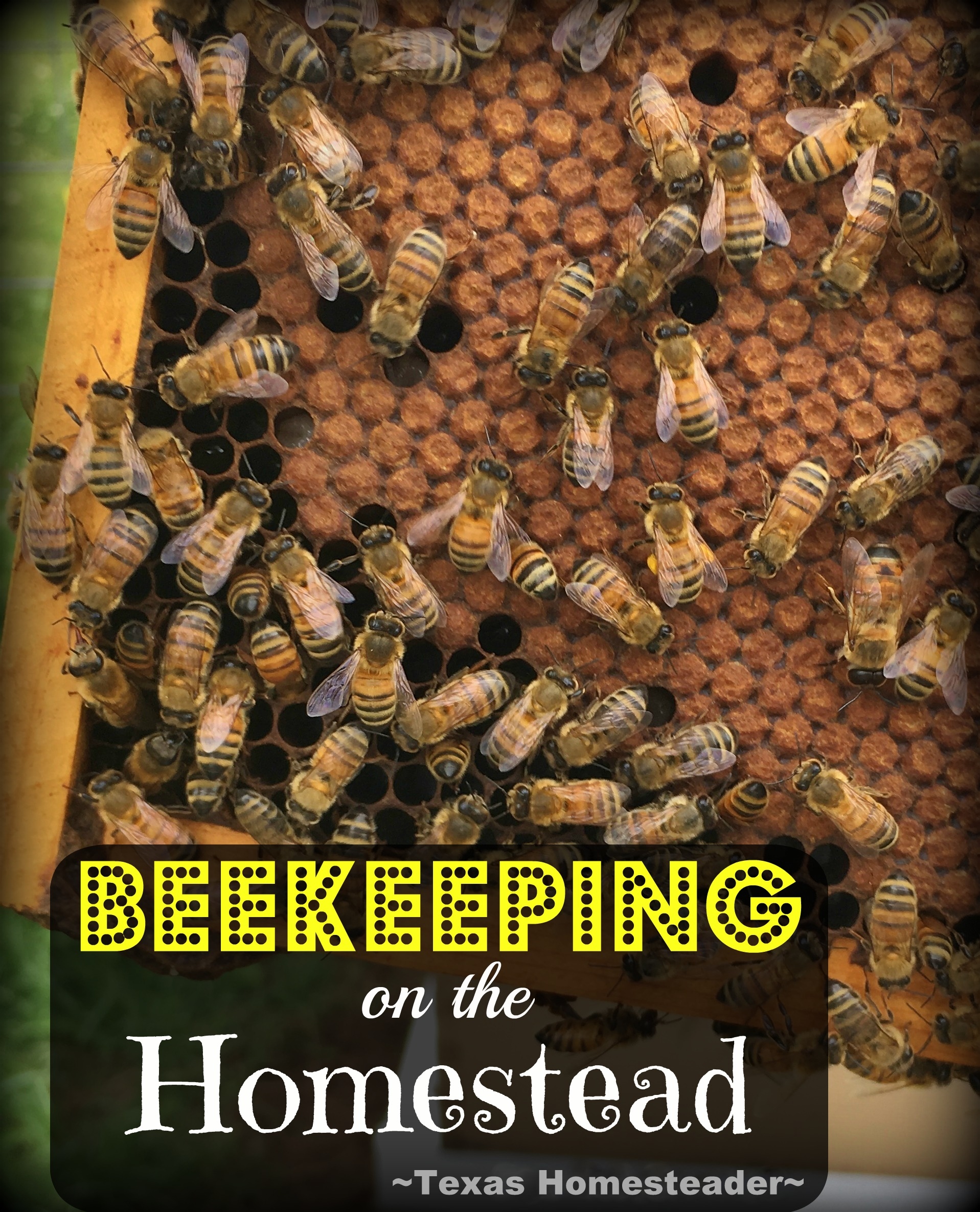
The main reason beekeepers split a beehive is to keep the hive from being too crowded.
If a hive feels they are running out of room & there are not enough frames to keep them busy they’ll gather up their queen and swarm to a new location. And that’s something no beekeeper wants since there’s been lots of time & effort into managing their apiary.
If a beekeeper is lucky they can recapture the swarm so they don’t lose half their bees! (you can see a video of how we Captured A Swarm in A Tree Here)
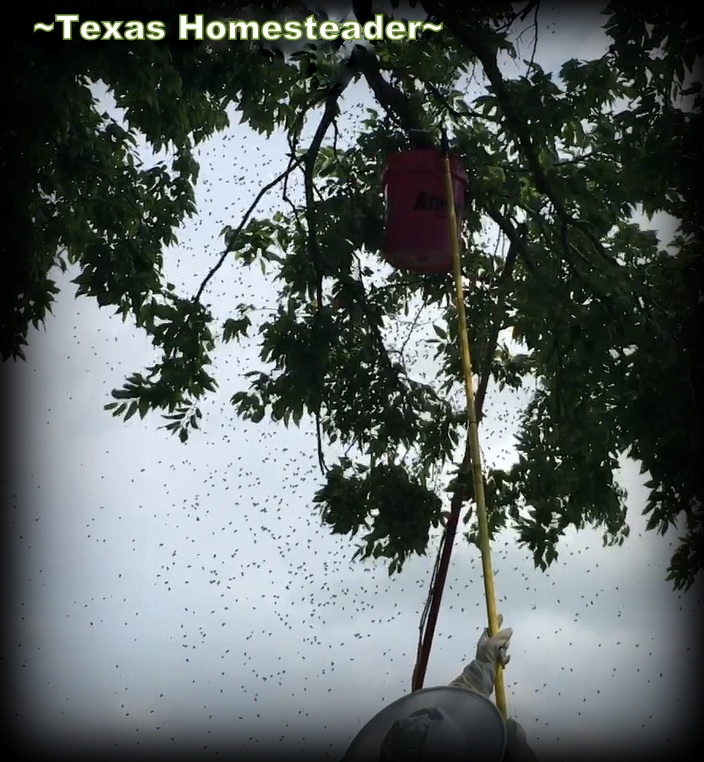
Not only does a split give the existing hive more room & empty frames to build and fill, but it also increases the beekeeper’s hives in the apiary!
There are two kinds of splits we utilize here on the Homestead:
I’ve previously written about the ‘Walk-Away Split‘ that we did in our hives last year. That was a Half-n-Half split. It’s certainly the faster & easier option to split a beehive.
We simply took the top box of our 2-box beehive & placed it atop a new bottom board. Then we put an empty deep hive box filled with empty frames on top of each hive and added a new lid to the new split hive & walked away.
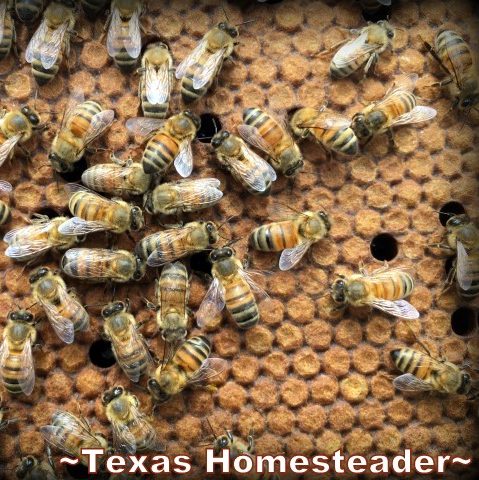
Of course one of the hives will already contain the existing queen. The other hive will simply make a new queen with one of the newest eggs contained in a frame.
Using frame-swap methods allows beekeepers to enhance the strength of new hives significantly.
The frame-swap strategy ensures that each new hive starts strong with the best resources.
Although the walk-away split is certainly easy, we prefer a frame-swap split instead. It seems to help both hives recover more quickly.
In a frame swap split you’re pulling filled frames from a strong hive and placing them in a brand new hive box.
When we’re ready to split the hive we pull the top & inner cover and inspect the frames in the top box of our strongest hive. RancherMan’s looking for a good mix of frames to move to the new hive.
He wants some frames of honey & pollen, some of capped & uncapped brood and some with new eggs.
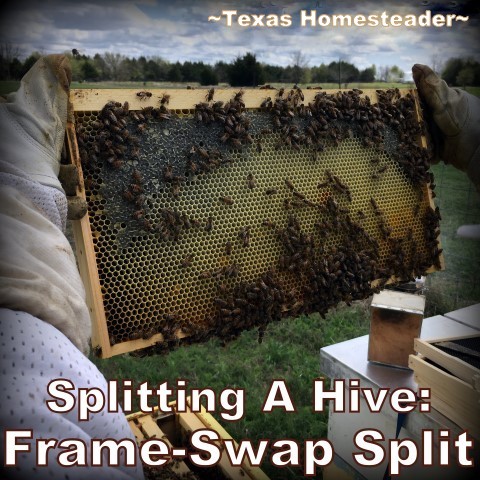
This is what we like to move from the strong hive into a new hive box:
Implementing a frame-swap can also aid in balancing the populations between hives.
As he chooses the frames to move to the new hive box he keeps as many worker bees on the frames as he can, but he’s looking for the queen.
He’d really like to keep her in the existing hive if possible.
When practicing frame-swap techniques, it’s vital to monitor how each hive adapts.
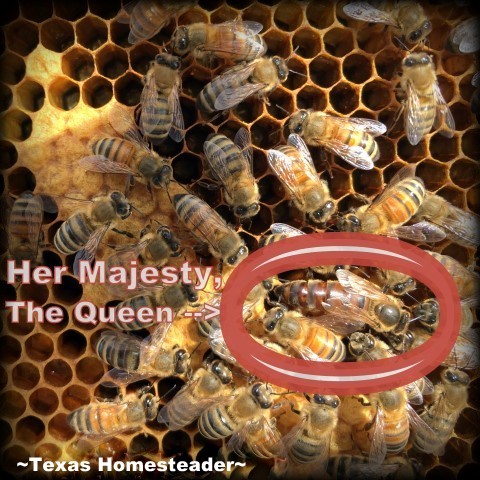
A frame-swap allows for better distribution of resources within your apiary.
But since the existing hive is two-deep-boxes high, it’s really not the end of the world if he doesn’t lay eyes on her.
He just would like to know which hive will contain an existing queen and which will take a little longer to recover because it will be making a new queen.
So after he’s moved the 4-5 filled frames to the new empty hive box, he’ll replace the frames he removed with empty frames to give the existing hive more room to build.
And to the new hive box he’ll add 4 empty frames and a frame feeder to finish outfitting the new hive. He’ll be feeding 1 part sugar dissolved into 1 part water to help the new hive along.
Adopting frame-swap techniques can lead to healthier, more productive hives.
Remember, a well-executed frame-swap can transform your beekeeping experience.
With frame-swap practices, you can witness remarkable changes in hive dynamics.
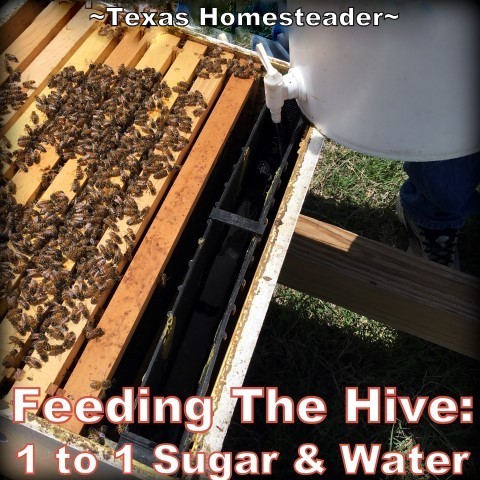
But we expect both the existing hive as well as the new split should be able to bounce back quickly & start filling the empty frames with brood and honey.
Engaging in frame-swap methodologies will significantly enhance your beekeeping skills.
For best results, incorporate frame-swap strategies regularly into your routine.
Finally we’ll put the tops on both hives and leave them alone while they settle and the new hive makes their new queen.
We’ll check the new hives in about 4 weeks to see if both contain a queen and to see how they’ve recovered. One hive will contain the original queen of course, and the other should have hatched a new queen by this time.
The new split hive probably won’t be ready for a honey super box expansion yet because they were set back trying to make a new queen.
But we’ll put honey super boxes on the existing hives so they can begin filling it with honey for our harvest. In this part of NE Texas our honey harvest is usually the first week of July.
~TxH~
Utilizing frame-swap techniques can lead to more efficient honey production.
Frame-swap is a proven method for improving colony viability and sustainability.

C’mon by & sit a spell! Come hang out at our Facebook Page . It’s like sitting in a front porch rocker with a glass of cold iced tea. There are lots of good folks sharing! And you can also follow along on Pinterest, Twitter or Instagram
If you’d like to receive an email when a new blog post goes live,
subscribe to our Blog!
Successful beekeeping often hinges on mastering frame-swap strategies effectively.
Table of Contents
- Why Split A Beehive?
- Beekeeping: What Is A Walk-Away Split?
- Beekeeping: What Is A Frame-Swap Split?
- Splitting Hives: Locating The Queen… or Not!
- Splitting The Hives – 1 Into 2!
- Beekeeping: Follow-Up Care After A Hive Split
- BEEKEEPING SERIES:
- See All Our Beekeeping Posts
We often do our splits by swapping empty frames for full ones. It was easy!
Frame-swap techniques are essential for maintaining hive health and maximizing honey production.

Why Split A Beehive?
The main reason beekeepers split a beehive is to keep the hive from being too crowded.
If a hive feels they are running out of room & there are not enough frames to keep them busy they’ll gather up their queen and swarm to a new location. And that’s something no beekeeper wants since there’s been lots of time & effort into managing their apiary.
If a beekeeper is lucky they can recapture the swarm so they don’t lose half their bees! (you can see a video of how we Captured A Swarm in A Tree Here)

Not only does a split give the existing hive more room & empty frames to build and fill, but it also increases the beekeeper’s hives in the apiary!
There are two kinds of splits we utilize here on the Homestead:
Beekeeping: What Is A Walk-Away Split?
I’ve previously written about the ‘Walk-Away Split‘ that we did in our hives last year. That was a Half-n-Half split. It’s certainly the faster & easier option to split a beehive.
We simply took the top box of our 2-box beehive & placed it atop a new bottom board. Then we put an empty deep hive box filled with empty frames on top of each hive and added a new lid to the new split hive & walked away.

Of course one of the hives will already contain the existing queen. The other hive will simply make a new queen with one of the newest eggs contained in a frame.
Beekeeping: What Is A Frame-Swap Split?
Using frame-swap methods allows beekeepers to enhance the strength of new hives significantly.
The frame-swap strategy ensures that each new hive starts strong with the best resources.
Although the walk-away split is certainly easy, we prefer a frame-swap split instead. It seems to help both hives recover more quickly.
In a frame swap split you’re pulling filled frames from a strong hive and placing them in a brand new hive box.
Splitting Hives: Locating The Queen… or Not!
When we’re ready to split the hive we pull the top & inner cover and inspect the frames in the top box of our strongest hive. RancherMan’s looking for a good mix of frames to move to the new hive.
He wants some frames of honey & pollen, some of capped & uncapped brood and some with new eggs.

This is what we like to move from the strong hive into a new hive box:
2 frames filled with honey
2 frames with brood and eggs
1 frame of empty built comb, if there’s one available
Then we’ll add to the new hive box:
Implementing a frame-swap can also aid in balancing the populations between hives.
3 empty frames (4 if no frame of built comb available from the strong hive)
Frame feeder
As he chooses the frames to move to the new hive box he keeps as many worker bees on the frames as he can, but he’s looking for the queen.
He’d really like to keep her in the existing hive if possible.
When practicing frame-swap techniques, it’s vital to monitor how each hive adapts.

A frame-swap allows for better distribution of resources within your apiary.
But since the existing hive is two-deep-boxes high, it’s really not the end of the world if he doesn’t lay eyes on her.
He just would like to know which hive will contain an existing queen and which will take a little longer to recover because it will be making a new queen.
Splitting The Hives – 1 Into 2!
So after he’s moved the 4-5 filled frames to the new empty hive box, he’ll replace the frames he removed with empty frames to give the existing hive more room to build.
And to the new hive box he’ll add 4 empty frames and a frame feeder to finish outfitting the new hive. He’ll be feeding 1 part sugar dissolved into 1 part water to help the new hive along.
Adopting frame-swap techniques can lead to healthier, more productive hives.
Remember, a well-executed frame-swap can transform your beekeeping experience.
With frame-swap practices, you can witness remarkable changes in hive dynamics.

But we expect both the existing hive as well as the new split should be able to bounce back quickly & start filling the empty frames with brood and honey.
Engaging in frame-swap methodologies will significantly enhance your beekeeping skills.
For best results, incorporate frame-swap strategies regularly into your routine.
Finally we’ll put the tops on both hives and leave them alone while they settle and the new hive makes their new queen.
Beekeeping: Follow-Up Care After A Hive Split
We’ll check the new hives in about 4 weeks to see if both contain a queen and to see how they’ve recovered. One hive will contain the original queen of course, and the other should have hatched a new queen by this time.
The new split hive probably won’t be ready for a honey super box expansion yet because they were set back trying to make a new queen.
But we’ll put honey super boxes on the existing hives so they can begin filling it with honey for our harvest. In this part of NE Texas our honey harvest is usually the first week of July.
~TxH~
BEEKEEPING SERIES:
- Preparing For the Hives
- Obtaining Your Bees
- Inspecting Your Hives
- Feeding Bees With A Frame-Feeder
- Expanding The Langstroth Hive
- Performing A Walk-Away Split
- Performing A Frame-Swap Split
- 5-Minute Beehive Stand
- Adding A Honey Super To Your Hive
- Catching A Bee Swarm (With Video)
- Requeening A Beehive – Things We Didn’t Know
- FOUR 5-Frame Nuc Boxes From 1 Sheet of Plywood!
- Varroa Mite Treatment For Your Apiary
- Preparing Your Hive For Honey Harvest
- Proper Honey Bottling Tips
- Purifying Your Beeswax
- MYO Beeswax Lip Balm
- Homemade Beeswax Jar Candles
- Beeswax Wraps – A Natural Solution To Plastic Wrap
…And MUCH More!
See All Our Beekeeping Posts
Utilizing frame-swap techniques can lead to more efficient honey production.
Frame-swap is a proven method for improving colony viability and sustainability.

C’mon by & sit a spell! Come hang out at our Facebook Page . It’s like sitting in a front porch rocker with a glass of cold iced tea. There are lots of good folks sharing! And you can also follow along on Pinterest, Twitter or Instagram
If you’d like to receive an email when a new blog post goes live,
subscribe to our Blog!
Successful beekeeping often hinges on mastering frame-swap strategies effectively.
